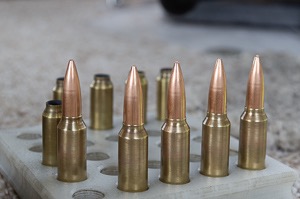Benchtalk
Case Annealing
by Stan Ware
I chose annealing because I believe it is important for many reasons and in asking around lately at shoots and I was surprised how many people who do not or do it incorrectly. Annealing is a process which changes the internal structure so the metal becomes softer. Sounds easy enough. As a smith I have made some flat springs and hardened them and then tempered them. This is a completely different process and not to be confused with annealing brass. Dipping hot steel in a salt quench hardens it in general and when applied to brass it softens it. Of course one needs to know at what temp and how often.

Lets start with a couple of methods I am sure you have heard of or tried. One being a pan of water that just covers about 1/3 of the bottom of the case . You heat the neck with the heat source until the brass starts to turn or glow and then you tip the case over and quench it in the water. The other being a lead pot with lead at the desirable temp and then dip the case mouth into the pot. I have tried this method and found that the lead likes to "weld" to the brass sometimes and holding the case is almost impossible with your fingers. Another method is a special circular tip that is added to you bernzomatic torch and lowered over the neck of the case until the desired temp is attained and then tipped over in the water much like the first plan I explained.
Looking at what the manufactures do in making brass is interesting. It basically starts out as a flat piece of copper and ends up a cartridge. It goes thru many steps before becoming a case. One thing is for sure it is annealed about seven times during the process and to keep the brass soft and workable. If it were not annealed it could not be formed in the radical shoulders and tapers without cracking.
First lets see what dictates why we anneal. First thing the brass flows some as it is fired and with some hot loads becomes hard and by hard I mean the brass work hardens from squeezing it down and and then firing it again and the end result is split necks. One thing that does help is turned necks that are concentric and bushing dies that do not squeeze the brass and does not work it as hard. (ie) if its expanded less and squeezed less you are better off. Each time the brass is squeeze back it adds to the work hardness and the only cure that I know is annealing.

At what temp ? Well, with brass nothing happens until around the 500 degrees area. Brass is completely annealed at around 600 degrees for one hour. Remember the lead pot ? lead melts at 625 approx. and one can see why the lead pot trick is a shot in the dark. At 662 degrees the brass structure has completely changed. I use the Ken Light annealer which heats them to about 750 to 800 degrees for a shorter time and will do the same thing as the longer time at around 600 degrees. One thing to remember here we are NOT trying to make the brass so soft that when it is slightly squeezed that it stays in that condition but we want it to spring back to where it starts out as. One can preform this act on the neck and it should come back to being round again or its too soft.

Take a look at new LAPUA brass and the bluish and dulled color that it is. That is what you want to try to copy. Yours may or may not be as pronounced but will get more color with time.
When to anneal depends on a few things. How hot your loads are, How many times you shoot them and the size of your chamber…. loose chamber means more working of the brass. Obviously if your shooting hot loads you will have to anneal more often and also the number of times you have to re-load them is also a factor. One thing you will notice is after annealing when using a hand die and seating bullets how uniform it is. Alot of shooters run into groups that enlarge and blame it on to many things. One thing…. when the brass releases the same all the way around I believe you have more consistency and that leads to better groups. Remember that accuracy is not one thing but a marriage of good bedding, good barrel, tight tolerances, good trigger, follow thru, etc… etc. I believe annealing is also in that category.

Don't forget when making new brass and fireforming that when you have completed the job, annealing them before starting to fire them is a good idea because you have set up alot of stress. Especially if your making and pushing brass around like a 30X47 out of 308 Winchester brass. You will be amazed how brittle and hard it has become from your pushing back and expanding and shrinking it.
We do welcome other opinions and comments.